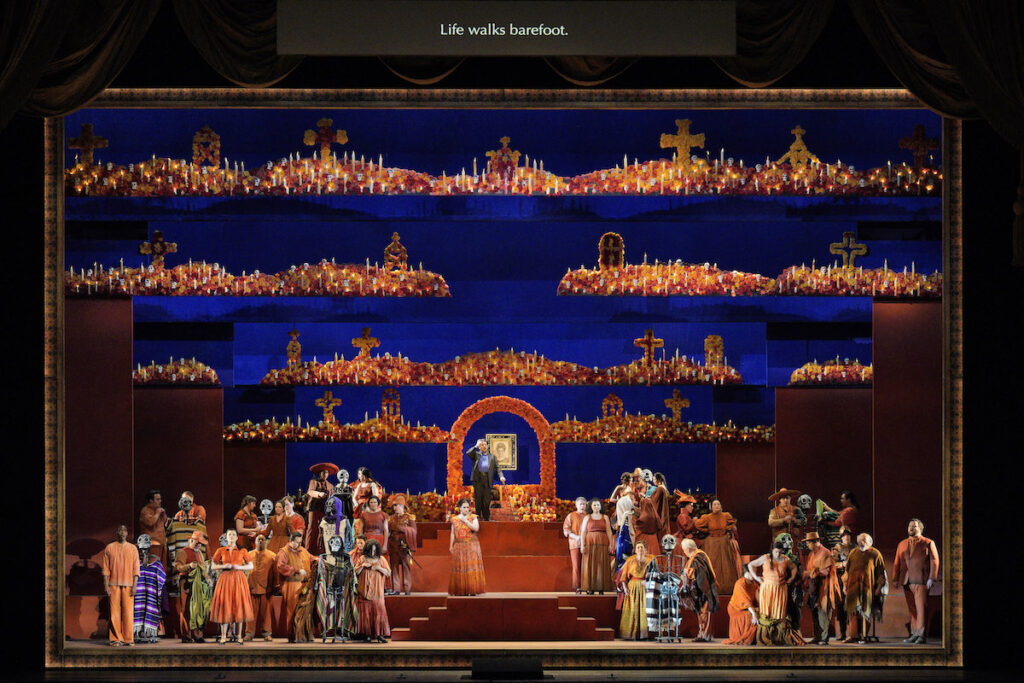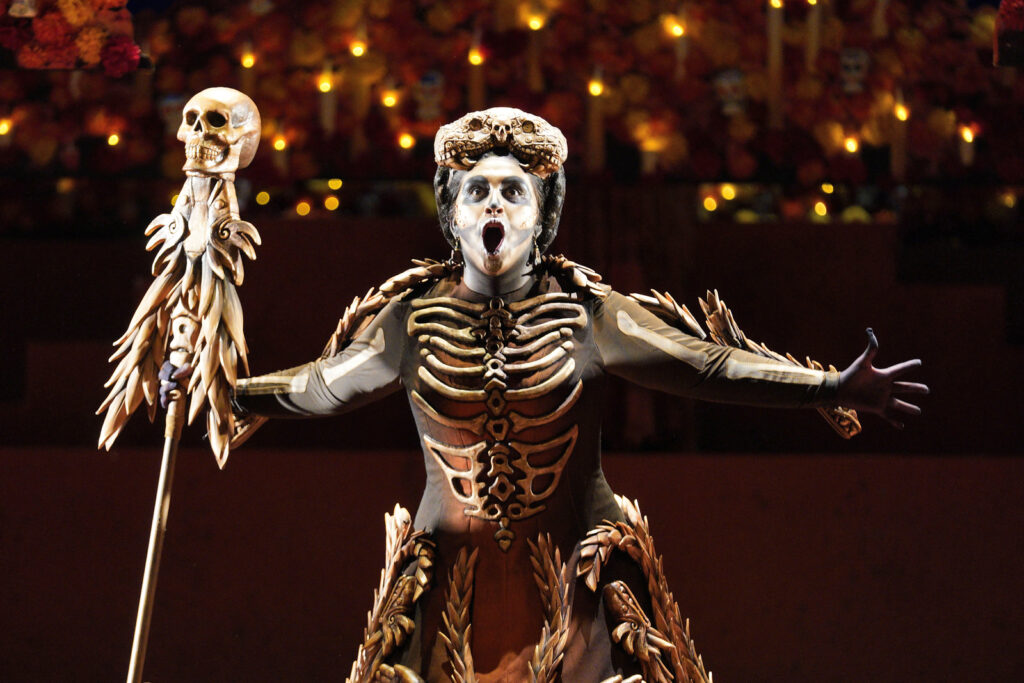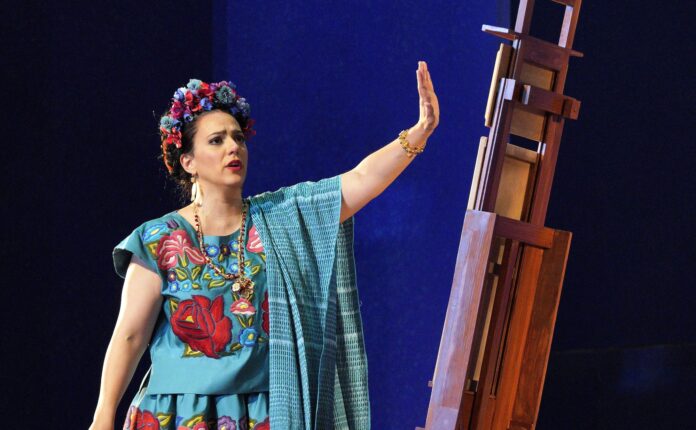Portraying dreams is one the unique advantages of art, regardless of medium. Still, narrative artists often fall into the trap of using dreams for lazy exposition, not all that different from plopping a news broadcast into a narrative. The alternative is often to portray dreams in such a way that their surreal and inexplicable nature frustrates those who approach the art seeking straightforward answers, despite the human mind being anything but straightforward during REM sleep.
SF Opera’s local premiere production of El último sueño de Frida y Diego (aka Frida and Diego’s Last Dream, which ran through June 30 at the War Memorial Opera House) tried to have it both ways, wanting to recreate the esoteric nature shown in the work of its two title characters, but also attempting to be digestible enough so as to not turn off audiences unfamiliar with that work. I saw the work—both the first from a woman composer on the main stage and the first to be presented in Spanish in the company’s 100-year history—via streaming on the SF Opera site. Although the opera may not have quite held together overall, it was a strikingly original journey.
Composer Gabriela Lena Frank and librettist Nilo Cruz regard the legendarily tumultuous marriage of Mexican painters Frida Kahlo (Argentine mezzo Daniela Mack) and Diego Rivera (Mexican baritone Alfredo Daza) in a way reminiscent of such lauded, and toxic, historical romances as Napoleon and Joséphine; albeit with considerably less fascism, but an equal amount of infidelity. Frank and Cruz (along with director Lorena Maza and conductor Roberto Kalb) show a love that not only endures once the two are separated, but also seems to bend the laws of reality as we know them.

It’s Día de Muertos, and famed painter Diego Rivera gives tribute to his beloved wife Frida, who died three years earlier. Like his fellow mourners, Diego wishes to be reunited with his departed love. Unbeknownst to him, the slumbering Frida has been made aware of his request and wonders why he reached out now, after three long years. At first, she has no interest in returning to the world that gave her nothing but “torture” all her life. But the opportunity to once again make a statement with her art is something she can’t pass up—even if it means reuniting with the man who broke her heart over and over.
It’s a bit too easy to compare Frida y Diego to other works because it seems to borrow from them at will. Frida’s reluctant journey back to the world of the living seems to recall the tale of Orpheus and Eurydice, which SF Opera produced just last year, for example. It’s also easy to make outside comparisons because the story of the opera seems loosely connected, as if Frank and Cruz had fragments of different story ideas that they stitched together. One is tempted to think they’re meant to add to a dreamlike atmosphere, but the story is too linear for that to be the case.
Frankly, a straightforward story of Frida returning to the land of the living may not have been that bad, especially since she’s essentially been given a sidekick in the form of “Greta Garbo” (US countertenor Jake Ingbar). It’s not really the cinema starlet, but rather the spirit of a man returning to the land of the living in the guise of Garbo for a fan (the man in drag is only addressed as Garbo, but the materials say his name is “Leonardo”). What’s more, the activities of the living and the dead are watched over—and occasionally interfered with—by the spirit Catrina (Chilean soprano Yaritza Véliz, stealing every scene she’s in), whom we’re never sure to regard as with or against our characters. All interesting stuff.

Unfortunately, the journey ends rather quickly, bringing Frida and Diego together early in the second act. Still, this too could have been a fine standalone story: The notoriously philandering Rivera, unable to work due to grief over his wife’s death, suddenly finds himself reunited with her. Yet, the two aren’t allowed to touch and every word they speak seems to reopen old wounds. The seeds of one or two great stories are in there, but they seem mashed together awkwardly, unable to properly fit together.
To the creators’ credit, they and their collaborators do an excellent job at visualizing both Kahlo and the world she created on canvas. Jorge Ballina’s set pieces float and fly in various directions, making even the “real” world seem magical. Diego walks through rows of flowers that ascend to the sky, he works in a studio in which he—particularly, next to his large blank canvas—seems small and insect-like by comparison. But the most striking pieces are when Frida is in the land of death or when she takes a journey through many of her most memorable paintings. As much as the proudly Mexican aesthetic seems to clash with the European instrumentation, the visuals are always lovely.
Help us save local journalism!
Every tax-deductible donation helps us grow to cover the issues that mean the most to our community. Become a 48 Hills Hero and support the only daily progressive news source in the Bay Area.
It’s a bold step to list Frida and Diego’s romance as one of history’s greats, especially since such a list often leans heavily on the Eurocentric. What’s more, the magical realism of a dreamlike atmosphere seems the only appropriate way to illustrate world through Kahlo’s eyes. Still, Frank, Cruz, and their collaborators seem a bit uncertain as to what sort of story should be told about this great romance. They visualize it perfectly, but they’re a bit too eager to make it fit into a box.
EL ÚLTIMO SUEÑO DE FRIDA Y DIEGO’s world premiere ran through June 30 at the War Memorial Opera House, SF.






